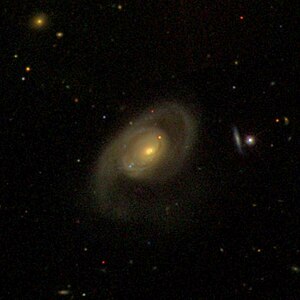NGC 5201
| Galaxy NGC 5201 |
|
|---|---|

|
|
| SDSS recording | |
| AladinLite | |
| Constellation | Big Bear |
|
Position equinox : J2000.0 , epoch : J2000.0 |
|
| Right ascension | 13 h 29 m 16.2 s |
| declination | + 53 ° 04 ′ 55 ″ |
| Appearance | |
| Morphological type | S? |
| Brightness (visual) | 13.2 mag |
| Brightness (B-band) | 14.1 mag |
| Angular expansion | 1.7 ′ × 1.1 ′ |
| Position angle | 145 ° |
| Surface brightness | 13.7 mag / arcmin² |
| Physical data | |
| Redshift | 0.029347 +/- 0.000030 |
| Radial velocity | 8798 +/- 9 km / s |
|
Stroke distance v rad / H 0 |
(398 ± 28) · 10 6 ly (121.9 ± 8.5) Mpc |
| history | |
| discovery | Wilhelm Herschel |
| Discovery date | April 14, 1789 |
| Catalog names | |
| NGC 5201 • UGC 8480 • PGC 47324 • CGCG 271-045 • MCG + 09-22-069 • IRAS F13273 + 5320 • 2MASX J13291617 + 5304554 • GC 3578 • H II 797 • LDCE 0975 NED003 | |
NGC 5201 is a 13.2 mag bright spiral radio galaxy of the Hubble type "S?" In the constellation Great Bear . It is estimated to be 398 million light years from the Milky Way and about 200,000 light years in diameter.
The object was discovered on April 14, 1789 by Wilhelm Herschel with an 18.7-inch reflector telescope, who described it as "pF, pS, R, vgbM".
